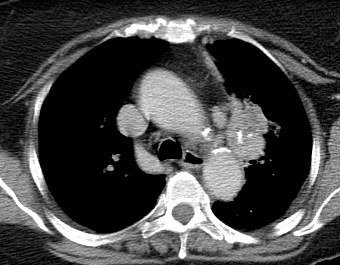Carcinoid Tumors of the Lung
|
General Considerations
- Formerly grouped as a type of bronchial adenoma
- Average age 40-50, males and females equally
- Most chronic, well-differentiated and least aggressive form of bronchial neuroendocrine tumors
- Metastasize infrequently
- Grow slowly
- Carcinoid syndrome may occur with large tumors or those that have metastasized but occurs in only 2% of cases of carcinoid tumor of the lung
- Carcinoid syndrome is more common with carcinoid tumors of the GI tract
Clinical Findings
- About 25% are asymptomatic at presentation
- Mostly due to bronchial obstruction, e.g. atelectasis and pneumonia
- May produce obstructive emphysema
- Hemoptysis
- Atypical carcinoids are more peripheral and more aggressive
Imaging Findings
- Most arise from a main or subsegmental bronchus
- Usually a mass central in location
- May produce atelectasis or obstructive pneumonia
- On CT, calcification is often seen
- On contrast-enhanced CT, carcinoid tumors may show densely-increased attenuation over pre-contrast studies
- They are not usually PET-scan positive
Treatment
- Most all are surgically removed
Prognosis
- Overall 5-year survival rate of 78-95% and a 10-year survival rate of 77-90%

Mouse over to enlarge
|
|
|
| |
|
|
|
Carcinoid Lung Tumors. MC Mancini. MedScape.
|
|